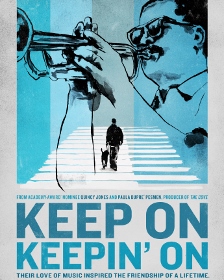As stars, supporters, and media personnel filed into the intimate Theater at the Tribeca Grand Hotel, one could already see the success, and consequent attention “Keep On Keepin’ On” has garnered.
Model Selita Ebanks, actor Hill Harper, young jazz innovator Jon Batiste, and the film’s producer the legendary Quincy Jones were a few of the big names in attendance to support the film. But, perhaps the biggest star of the night was Justin Kauflin, the inspiring young jazz pianist that the documentary focuses on. By this time the film had already received the Tribeca Film Festival awards for “Best New Documentary Director” and the “Heineken Audience Award”, so the pressure was officially off; it was already a certified good film. This meant this special screening could focus on celebrating of story worth telling and the people who came together to make a dream come true.
The story follows Justin Kauflin over a 4 year span as he tries to make it as a jazz artist in New York. There are three things that separate Justin immediately from all his competitors; the fact that he is blind is probably the easiest to discern. The second comes as soon as his fingers slide across the keys of a piano; it is clear to see he possesses an enormous amount of talent and brilliance. The third is that his jazz mentor is none other than one of the greatest musicians to ever pick up a trumpet, Clark Terry (mentor to such greats as Quincy Jones and Miles Davis). The audience becomes invested in the story as we watch the Justin and Clark grow closer and closer due to their love of music and relatable health issues. Director Alan Hicks’ ability to thread the swells and peaks of jazz music with the valleys and obstacles Justin and Clark face throughout the film makes for a compelling piece. While most of the film is focused on Justin’s preparation for an elite international competition, the importance of the competition is eclipsed by the importance of the relationship Justin and Clarke share as mentor and mentee. The story comes to a head when Quincy Jones enters near the end, but for that part you will have to see the film.
Director Alan Hicks frames Justin Kauflin’s story with respect and reverence for not only the art form of jazz, but for the struggle of the lives involved. This makes the film genuine and pulled at the heartstrings of every audience member caught under its spell.
After watching the documentary, check out Justin Kauflin’s music and see why so many have already been inspired by his life and captivated by his gift of music.
http://www.justinkauflin.com
You can check out this documentary at Landmark Sunshine Cinema and Lincoln Plaza 6 theater in New York on Oct. 3.
-JT Tarpav
